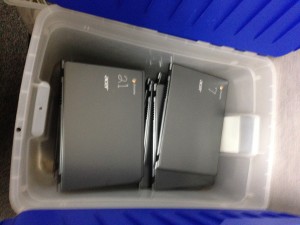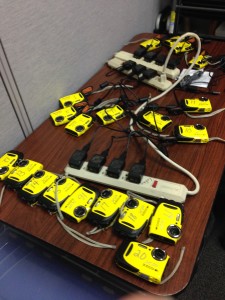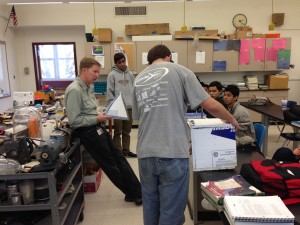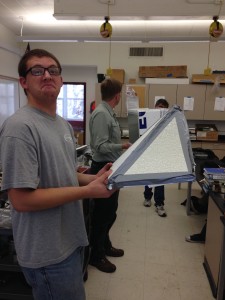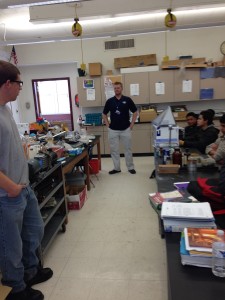This is cross posted at the “High Hopes Project” blog
Lake Tahoe to Pyramid Lake from about 29,000 meters (95,000 feet)
The “High Hopes Project” is designed to be a model global STEM learning project. But what is it really and how does it work? Who is involved? How can my students and I be involved?
Last year we dropped GoPro cameras 45 feet deep in Lake Tahoe and pulled them up to almost 30,500 meters (100,000 feet) attached to a high altitude weather balloon to investigate how that would work. No students were involved in that trial.
Well that has changed. We (see below) are planning launches from several Reno and Fernley, Nevada, area schools this spring. Tentative dates are the last week in April, and from crystal clear Lake Tahoe in June. These launches will include payloads designed by local students. At least 2 of the payloads will carry the “High Hopes” of the world to near space and release them. Teachers and their students (that’s you!) can participate by writing and submitting your “High Hopes via a Google Spreadsheet or via Twitter.
We are collecting “High Hopes” for your school, community and the world, from students and others around the globe – we’ve already received hundreds from local students, but also students from as far away as Norway and France.
Here are more specifics about the project including ways for you or anyone to join in:
Sparks High School students are designing and building a water pressure gauge to track water pressure from 45 meters (150 feet) deep in Lake Tahoe to the surface. An air pressure gauge will monitor air pressure to 30,500 meters (100,000 feet) or higher. Students from around the world will be invited to research to determine what will happen to the water and air pressure during flight, and we will share the data we bring back so they can assess their understanding.
Sparks High Students are also challenged to engineer a way to reel in the 45 meters (150 feet) of line with the cameras and water pressure gauge up to the bottom payload. Leaving the cameras dangling far below could cause instability during the flight, so this is an important engineering problem to solve. The students also designed the actual payloads to carry the “High Hopes” of the world up to 30,500 meters (100,000 feet), and then release the tiny strips of paper they will be printed on to spread in the atmosphere – Now they’ve turned those payloads over to Sparks Middle School students to install the release mechanism they are designing.
Sparks Middle School students will be learning about writing computer code and designing a system utilizing Ardunio micro-computers. They will conduct low altitude tests using model rocketry to determine an effective way of accurately measuring altitude using the Arduino system and then use the knowledge gained from these tests to design a system to release the high hopes of the world at at least two different altitudes as the balloon is in flight.
Students at Cottonwood Elementary in Fernley (a K-4 school) are designing special high hopes to glide or helicopter to the ground – these high hopes will be launched at a lower altitude, around 6100 meters (20,000 feet) so the atmosphere is thick enough for them to take flight. They will also perform experiments utilizing bio-engineering to find a substance to treat the paper with so it decomposes as fast as possible once the “Hopes” hit the ground. The elementary students will utilize their new blogging skills and other means to encourage everyone to submit their “High Hopes.”
One payload will include colorful party balloons inflated to different sizes. We challenge students everywhere to research to determine what will happen to them as they rise through atmospheric layers to 30,500 meters (100,000 feet). Onboard cameras will record what occurs and we will share the photos/video obtained so students globally can see what transpired. In addition, we will monitor temperature and other data during the flights and share that data as well.
The High Hopes Project is planned as a model global STEM (Science, Technology, Engineering and Math) project so teachers, students and the community are better educated in the powerful learning a quality integrated STEM approach provides. There will be creative writing ideas, math and more offered along the way. These lesson ideas and challenges will be linked on our project Wiki page. Check back often to see new information and challenges.
You Can Participate too! Teachers and students (really anyone!) can participate by: 1) Brainstorming, writing and submitting their “High Hopes” for their school, community and the world. 2) Participating in the science, engineering and math challenges we offer. 3) Follow our progress via the various social networks we are utilizing to inform and include the world (see links below).
There are other aspects of this project that are developing and we will share later as well.
Additionally, we have partnered with the University of Nevada, Reno, Mechanical Engineering and Materials Science Departments. They are experts in launching high altitude balloons, but are also encouraging undergraduate and graduate level engineering students to work with and mentor students at Sparks High School, Sparks Middle School and Cottonwood Elementary School.
This is a collaborative project between Nevada’s Northwest Regional Professional Development Program, the 21st Century Division of WCSD, the Lyon County School District, the Washoe County School District, the University of Nevada, Reno, and students from around the world.
Here are links to our online resources – this is how we are modelling the “T” part of STEM – these links will also provide you much more specific information about the project:
Our blog: http://highhopesproject.edublogs.org
Our Web Site: http://highhopesproject.net
Our Twitter page: https://twitter.com
Our Flickr page: https://www.flickr.com/photos/127331960@N04/sets/
Our YouTube Channel: https://www.youtube.com/channel/UCM6JGyKhW2OXYiY9gh3J-Lg/videos
Learning is messy!!!

